Advertisement

How are the Voyager spacecraft able to transmit radio messages so far?
- Share Content on Facebook
- Share Content on LinkedIn
- Share Content on Flipboard
- Share Content on Reddit
- Share Content via Email
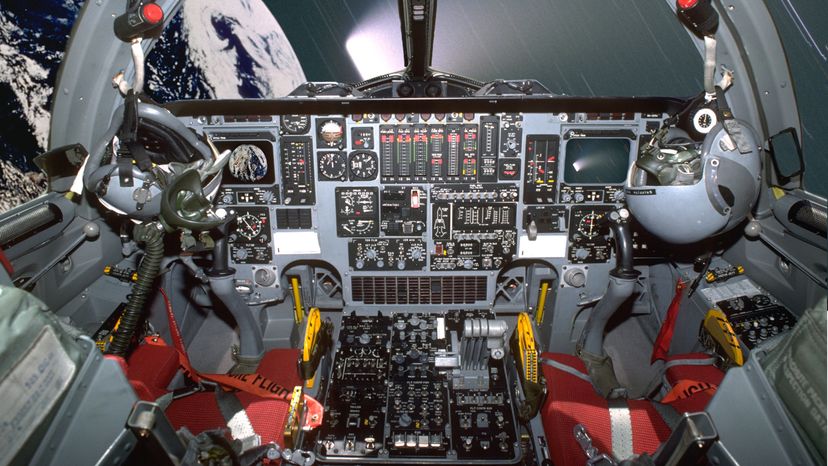
The two Voyage spacecraft certainly have had an amazing track record. They were sent to photograph planets like Jupiter, Saturn and Neptune and have just kept on going past the outer edge of the solar system. Voyager 1 is currently over 7 billion miles (about 11 billion kilometers) away from Earth and is still transmitting -- it takes about 10 hours for the signal to travel from the spacecraft to Earth!
The Voyager spacecraft use 23-watt radios. This is higher than the 3 watts a typical cell phone uses, but in the grand scheme of things it is still a low-power transmitter. Big radio stations on Earth transmit at tens of thousands of watts and they still fade out fairly quickly.
The key to receiving the signals is therefore not the power of the radio, but a combination of three other things:
- Very large antenna dishes
- Directional antennas that point right at each other
- Radio frequencies without a lot of man-made interference on them
The antenna dishes that the Voyager spacecraft use are big. You may have seen people who have large satellite dishes in their yards. These are typically 2 or 3 meters (6 to 10 feet) in diameter. The Voyager spacecraft has an antenna dish that is 3.7 meters (14 feet) in diameter, and it transmits to a 34 meter (100 feet or so) dish on Earth. The Voyager dish and the Earth dish are pointed right at each other. When you compare your phone's stubby, little omni-directional antenna to a 34 meter directional antenna, you can see the main thing that makes a difference!
The Voyager satellites are also transmitting in the 8 GHz range , and there is not a lot of interference at this frequency. Therefore the antenna on Earth can use an extremely sensitive amplifier and still make sense of the faint signals it receives. Then when the Earth antenna transmits back to the spacecraft, it uses extremely high power (tens of thousands of watts) to make sure the spacecraft gets the message.
Frequently Asked Questions
What role do earth's ground stations play in receiving signals from distant spacecraft like voyager, how has technology advanced to maintain communication with voyager as it moves further away.
Please copy/paste the following text to properly cite this HowStuffWorks.com article:
- The Magazine
- Stay Curious
- The Sciences
- Environment
- Planet Earth
Our Radio Signals Have Now Reached 75 Star Systems That Can See Us Too
We have been broadcasting for over 100 years. now a new 3d map of the galaxy reveals the stars these signals have reached that can also see earth..

When Guglielmo Marconi made the first “long-distance” radio broadcasts in 1895, his assistant tuned into from a less than a kilometer away. Marconi went on to develop the world’s first commercial radio system and, by the time of his death in 1937, radio signals were routinely used to communicate across the world.
These broadcasts have also travelled into space, signaling to all who care to tune in, that humanity has emerged as a technologically advanced species. The first signals have now been travelling for over hundred years, reaching distances that would have been unimaginable to Marconi.
That raises some interesting questions about the stars these signals have already reached. What kind of stars are they, do they host exoplanets and if so, are any potentially Earth-like and in the habitable zone? How many of these exoplanets might also be able to see us?
Now we get an answer thanks to the work of Lisa Kaltenegger at Cornell University in Ithaca and Jackie Faherty at the American Museum of Natural History in New York City. These astronomers have calculated the size of the sphere that our radio signals have covered since they left Earth, counted the stars that sit inside it and worked out which of them should also be able to see Earth transiting the Sun.
3D Star Map
All this is made possible by the Gaia Catalogue, a new 3D map of our galaxy showing the distance and motion of more than 100 million stars. The data comes from the European Space Agency’s Gaia spacecraft that was launched in 2013 and is mapping the position and motion of some 1 billion astronomical objects.
The resulting map is giving astronomers an entirely new way to study our galactic environment. Kaltenegger and Faherty’s project is a good example. Since Gaia measures how these stars are moving relative to one another, the researchers can work out for how long we have been visible to them and for how much longer.
Kaltenegger and Faherty say 75 stars systems that can see us, or soon will, sit within this 100 light year sphere. Astronomers have already observed exoplanets orbiting four of them.
These systems are generally well studied. The researchers say, for example, that the Ross128 star system is the 13th closest to the Sun and the second closest with a transiting Earth-size exoplanet. Then there is Teegarden’s Star, with at least two Earth-mass exoplanets and the Trappist-1 star system with seven Earth-sized planets, of which four are in the habitable zone.
Our signals continue to radiate away from us. So Kaltenegger and Faherty also pick out at the star systems set to receive our signals in the next 200 years or so and will also be able to see us. “1,715 stars within 326 light-years are in the right position to have spotted life on a transiting Earth since early human civilization, with an additional 319 stars entering this special vantage point in the next 5,000 years,” they say.
Rocky Exoplanets
Exoplanet statistics suggest that at least 25 per cent of these stars will have rocky exoplanets. So there should be at least 508 rocky planets in this population with a good view of earth. “Restricting the selection to the distance radio waves from Earth have traveled- about 100 light-years - leads to an estimated 29 potentially habitable worlds that could have seen Earth transit and also detect radio waves from our planet,” say Kaltenegger and Faherty.
Of course, the possibility of life on these worlds is entirely unknown. The next generation of space telescopes should allow astronomers to study these worlds in more detail, to determine their atmospheric make up and perhaps see continents and oceans.
To similarly equipped alien eyes, Earth will have long looked an interesting target. Life first emerged here some 4 billion years ago, ultimately giving our atmosphere its rich oxygen content and its other biomarkers, such as methane. If astronomers find similar conditions elsewhere, that will pique their interest.
It could even prompt searches for radio signals that may already be reaching us from these places. Marconi would surely have been amazed.
Ref: Past, Present And Future Stars That Can See Earth As A Transiting Exoplanet : arxiv.org/abs/2107.07936
Already a subscriber?
Register or Log In

Keep reading for as low as $1.99!
Sign up for our weekly science updates.
Save up to 40% off the cover price when you subscribe to Discover magazine.

Radio Waves

WHAT ARE RADIO WAVES?
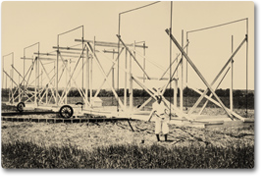
Radio waves have the longest wavelengths in the electromagnetic spectrum. They range from the length of a football to larger than our planet. Heinrich Hertz proved the existence of radio waves in the late 1880s. He used a spark gap attached to an induction coil and a separate spark gap on a receiving antenna. When waves created by the sparks of the coil transmitter were picked up by the receiving antenna, sparks would jump its gap as well. Hertz showed in his experiments that these signals possessed all the properties of electromagnetic waves.
You can tune a radio to a specific wavelength—or frequency—and listen to your favorite music. The radio "receives" these electromagnetic radio waves and converts them to mechanical vibrations in the speaker to create the sound waves you can hear.
RADIO EMISSIONS IN THE SOLAR SYSTEM
Astronomical objects that have a changing magnetic field can produce radio waves. The radio astronomy instrument called WAVES on the WIND spacecraft recorded a day of bursts of radio waves from the Sun's corona and planets in our solar system.
Data pictured below show emissions from a variety of sources including radio bursts from the Sun, the Earth, and even from Jupiter's ionosphere whose wavelengths measure about fifteen meters in length. The far right of this graph shows radio bursts from the Sun caused by electrons that have been ejected into space during solar flares moving at 20% of the speed of light.
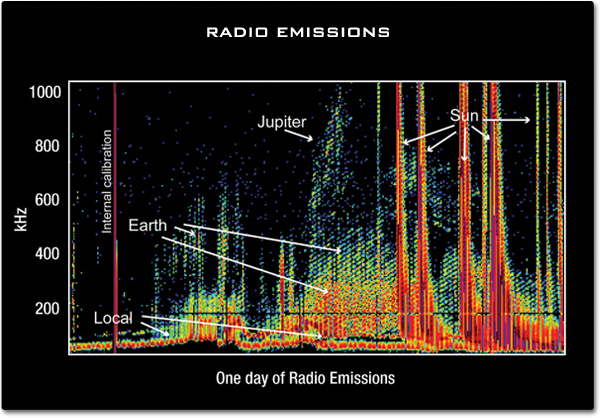
RADIO TELESCOPES
Radio telescopes look toward the heavens to view planets, comets, giant clouds of gas and dust, stars, and galaxies. By studying the radio waves originating from these sources, astronomers can learn about their composition, structure, and motion. Radio astronomy has the advantage that sunlight, clouds, and rain do not affect observations.
Since radio waves are longer than optical waves, radio telescopes are made differently than the telescopes used for visible light. Radio telescopes must be physically larger than an optical telescopes in order to make images of comparable resolution. But they can be made lighter with millions of small holes cut through the dish since the long radio waves are too big to "see" them. The Parkes radio telescope, which has a dish 64 meters wide, cannot yield an image any clearer than a small backyard optical telescope!
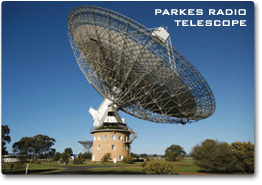
A VERY LARGE TELESCOPE
In order to make a clearer, or higher resolution, radio image, radio astronomers often combine several smaller telescopes, or receiving dishes, into an array. Together, these dishes can act as one large telescope whose resolution is set by the maximum size of the area. The National Radio Astronomy Observatory's Very Large Array (VLA) radio telescope in New Mexico is one of the world's premier astronomical radio observatories. The VLA consists of 27 antennas arranged in a huge "Y" pattern up to 36 km across (roughly one-and-one-half times the size of Washington, DC).
The techniques used in radio astronomy at long wavelengths can sometimes be applied at the shorter end of the radio spectrum—the microwave portion. The VLA image below captured 21-centimeter energy emissions around a black hole in the lower right and magnetic field lines pulling gas around in the upper left.
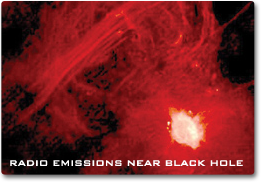
THE RADIO SKY
If we were to look at the sky with a radio telescope tuned to 408 MHz, the sky would appear radically different from what we see in visible light. Instead of seeing point-like stars, we would see distant pulsars, star-forming regions, and supernova remnants would dominate the night sky.
Radio telescopes can also detect quasars. The term quasar is short for quasi-stellar radio source. The name comes from the fact that the first quasars identified emit mostly radio energy and look much like stars. Quasars are very energetic, with some emitting 1,000 times as much energy as the entire Milky Way. However, most quasars are blocked from view in visible light by dust in their surrounding galaxies.
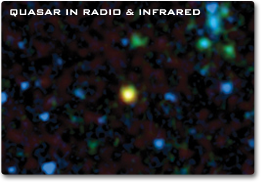
Astronomers identified the quasars with the help of radio data from the VLA radio telescope because many galaxies with quasars appear bright when viewed with radio telescopes. In the false-color image below, infrared data from the Spitzer space telescope is colored both blue and green, and radio data from the VLA telescope is shown in red. The quasar-bearing galaxy stands out in yellow because it emits both infrared and radio light.
Next: Microwaves
National Aeronautics and Space Administration, Science Mission Directorate. (2010). Radio Waves. Retrieved [insert date - e.g. August 10, 2016] , from NASA Science website: http://science.nasa.gov/ems/05_radiowaves
Science Mission Directorate. "Radio Waves" NASA Science . 2010. National Aeronautics and Space Administration. [insert date - e.g. 10 Aug. 2016] http://science.nasa.gov/ems/05_radiowaves
Discover More Topics From NASA
James Webb Space Telescope

Perseverance Rover

Parker Solar Probe

- Red Light, Green Light
- Engineering Healthy Silence: Using Noise-Cancelling Headphones to Block Harmful Sound
- Crushing the Sound Barrier
- The Powers of Melanin
- E-Ink Technology: the Secret Behind Kindle

USC Viterbi School of Engineering
Catch a Wave: Radio Waves and How They Work
About the Author: Andrew Schnickel
In Fall 2000, Andrew Schnickel was a Junior majoring in CECS who enjoyed running barefoot in the rain.
Introduction
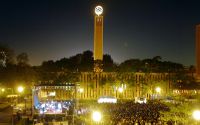
You are driving down the open road, not a care in the world. It’s a sunny summer day and you have the car windows down. Everything seems almost perfect, yet something is missing. You turn on the radio, tune it to your favorite station (see Fig. 1), and instantly the car fills with sound. Suddenly, everything feels right. Radio is something most of us take for granted. Have you ever stopped to consider how a radio works? How does a radio know which station to play? What is AM, what is FM, and how are the two different? Why does FM sound better, but AM can be heard farther away? You have probably experienced a time when finding a particular radio station has been difficult. There are many factors involved in finding and receiving stations, factors such as modulation, broadcasting power, time of day, and geographical location. The key to getting the most out of your radio is to understand how radio works and how engineering has played a part in the development of a device which most of us use everyday.
Radio Basics
Am and fm differences.
Two characteristics, amplitude and frequency (see Fig. 2), mark the difference between AM and FM radio. AM stands for amplitude modulation, which means the amplitude of the radio signal is used to encode information. FM denotes frequency modulation, which uses a change in frequency to encode information. From this you can see that both AM and FM radio use modulation to encode information. “Modulation is the variation of some property of the radio carrier in a manner that conveys information” [1].
Modulation Explained
Amplitude modulation (am), frequency modulation (fm), sound quality and performance, signal strength, frequency range, interference, broadcast range.
- [1] J.J. Carr. “Elements of Electronic Communications.” Reston, Virginia: Reston Publishing Company, Inc., 1978.
- [2] R.S. Carson. “Radio Communications Concepts: Analog.” New York: John Wiley & Sons, 1990.
- [3] Editors and Engineers The “Radio” Handbook. Los Angeles: Editors and Engineers, 1942.
- ← Minerva: A Pioneer in Everyday Robots
- Fuel Injection →
Similar Posts

Chemical Engineering Your Dinner

Inside a Slot Machine

Engineering a Smooth Ride: Creating the Perfect Ski Through Shaping and Vibration Damping
Leave a reply cancel reply.
Your email address will not be published. Required fields are marked *
Small Business Productivity, Tools and Tips – Android and iPhone Sync
What radio waves can travel through and what they cannot.
When Guglielmo Marconi began research into long-range radio in the late 19th century, the scientific community was skeptical. That he succeeded in transmitting radio signals more than 2000km met with much astonishment. What he had unwittingly done was discover the ionosphere, a layer in the atmosphere that is ionized to a degree by the sun’s ultraviolet rays.

This affects radio waves and reflects them to earth, which bounces them upwards again. This repeated sequence enables us to transmit radio waves around the world. So, if radio waves can’t penetrate the ionosphere, what else will hinder them? Let’s look at what radio waves consist of, and then we’ll talk about their ability or otherwise to pass through certain materials.
Radio Waves Explained
Developments in radio technology have brought us a long way in the past 100 years and more, but how do radio waves work? Before Marconi’s discovery, scientists believed that radio signals could only travel a straight line, as they were known to do in free space. Hence, there was a necessity for tall towers from which to transmit signals. A 100m high tower, for example, could send a signal up to around 30km, the limit set by the curvature of the earth. Marconi showed that radio waves could be bent and bounced by the ionosphere.
Radio waves form a small part of what is known as the electromagnetic spectrum (EMS). This consists not just of radio waves but also other forms of electromagnetic radiation such as gamma rays, microwaves, visible light, and more. Radio waves have among the longest wavelengths on the EMS. Imagine a rope held between two people. Move the rope up and down at one end, and a waveform moves across the rope.
This is what a radio wave would look like if we could see it. The wavelength is the distance between two ‘peaks’ in the wave. We also have to consider the frequency, which the number of waves that pass a given point in a set time. This is vital to understand so that different transmissions do not interfere with each other.
Television signals are radio waves, but they are broadcast in a different frequency range to the radio.
What has this to do with the materials that radio waves can and cannot pass through? Let’s look more closely at this.
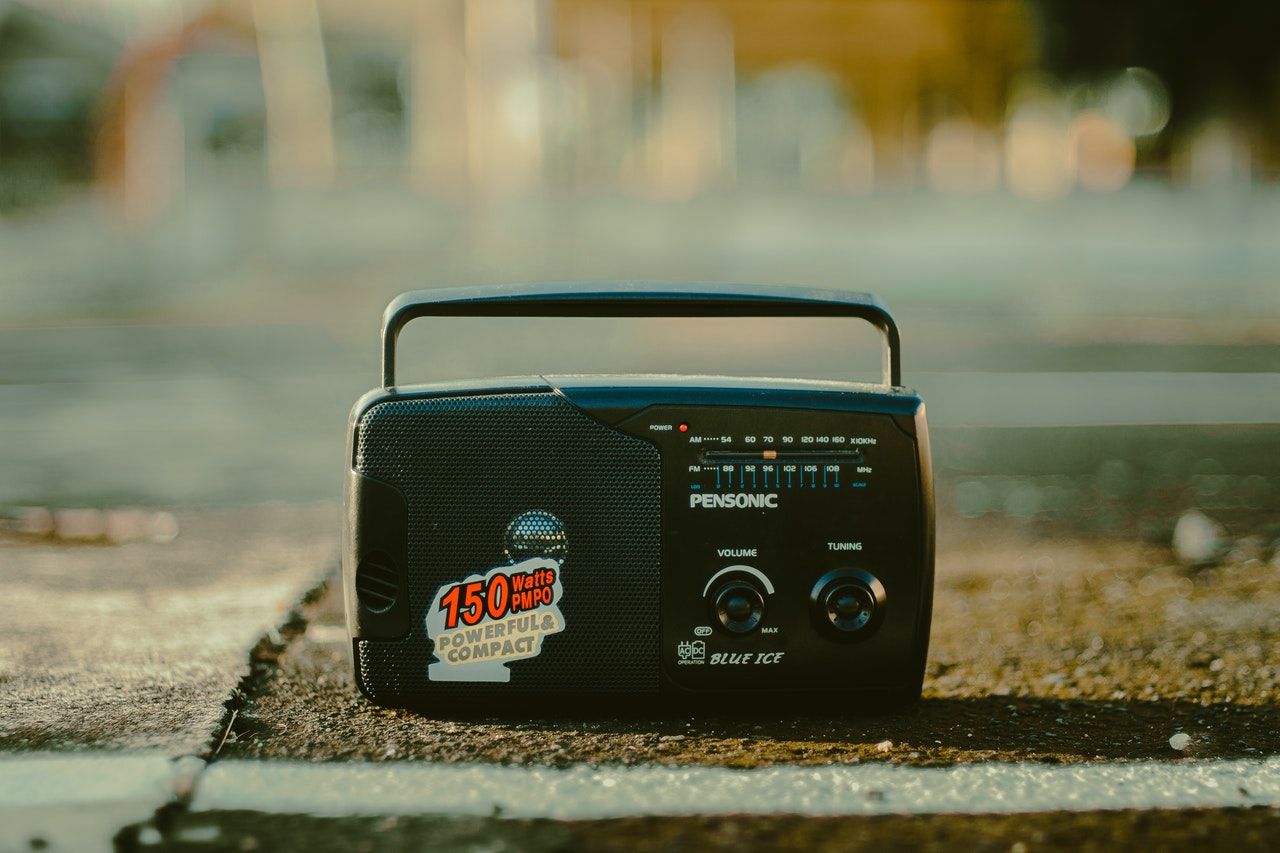
What Can’t Radio Waves Pass-Through?
We’ve already seen that radio waves do not penetrate the ionosphere. We should explain that this refers to radio waves of up to 40MHz, the highest frequency bounced off the ionosphere. Why do radio waves bounce back?
As we mentioned, the ionosphere is partly ionized.
This is because the UV light from the sun causes electrons to shake free from atoms, leaving a large proportion of free electrons hanging about in the ionosphere. When a radio wave hits the ionosphere, the energy created by the free electrons, as a result, causes the radio waves to be repelled or reflected.
So, we know that radio waves up to 40MHz won’t pass through an ionized layer in the atmosphere. Remember that we explained the perceived limitations of radio transmissions before Marconi’s discovery. A line of sight was necessary, without obstructions, for successful transmission.
In some radio transmissions, interference can be caused by the waves being blocked by materials that they cannot penetrate. While radio waves can move through wood, bricks, and concrete to a certain extent, these materials can still cause interference. This is because radio waves meeting such objects can be reflected from buildings and other large structures, just like the ionosphere. This explains why the reception of radios and other radio frequency devices such as smartphones vary between locations.
For the record, as it covers a large bandwidth necessarily, television signals need to be above 40MHz so they cannot be bounced off the ionosphere, hence the tall towers in high locations used for TV transmissions.
Radio waves will also be adversely affected by metal and water, which they cannot pass through. That is because water and metal are both electrical conductors. Like the ionosphere, metal and water contain many free electrons, which will vibrate when a radio wave hits the surface, and the wave will bounce back.
To summarize, we now know that radio waves are affected by free electrons in electrical conductors such as metals and water and cannot pass through these materials.
We have discovered that they can pass through non-conducting materials quite well but are losing propagation power with reflecting surfaces such as water, metal, and other materials. Furthermore, worldwide radio transmission is made possible by the radio waves being reflected by the ionosphere and the earth in a continuous sequence, allowing for transmissions to be made across great distances.
Comments are closed.
Why does it take so long for the radio waves to travel through space?
Actually, radio waves travel very quickly through space. Radio waves are a kind of electromagnetic radiation, and thus they move at the speed of light. The speed of light is a little less than 300,000 km per second. At that speed, a beam of light could go around the Earth at the equator more then 7 times in a second.
The reason that it takes so long for radio messages to travel in space is that space is mind-bogglingly big. The distances to be traveled are so great that even light or radio waves take a while getting there. It takes around eight minutes for radio waves to travel from the Earth to the Sun, and four years to get from here to the nearest star.
How long does it take for transmissions to get between DS1 and Earth? How often is DS1 in communication with Earth? What are radio waves?
How is lag dealt with? Why does the data transfer rate have to drop with distance? What kind of data is DS1 sending back? How do the instruments and sensors coordinate sending signals? How much data is DS1 able to transfer? What is electromagnetic radiation?
How do you make a radio wave?
- The Inventory
Why Do Radio Signals Travel Farther at Night Than in the Day?
Not all radio waves travel farther at night than during the day, but some, short and medium wave, which AM radio signals fall under, definitely can given the right conditions. The main reason this is the case has to do with the signal interacting with a particular layer of the atmosphere known as the ionosphere, and how this interaction changes from the nighttime to the daytime.
The ionosphere is a layer of the upper atmosphere about 50 to 600 miles above sea level. It gets its name because it is ionized consistently by solar and cosmic radiation. In very simple terms, X-ray, ultraviolet, and shorter wavelengths of radiation given off by the Sun (and from other cosmic sources) release electrons in this layer of the atmosphere when these particular photons are absorbed by molecules. Because the density of molecules and atoms is quite low in the ionosphere (particularly in the upper layers), it allows free electrons to exist in this way for a short period of time before ultimately recombining. Lower in the atmosphere, where the density of molecules is greater, this recombination happens much faster.
Related Content
What does this have to do with radio waves? Without interference, radio waves travel in a straight line from the broadcast source, ultimately hitting the ionosphere. What happens after is dependent on a variety of factors, notable among them being the frequency of the waves and the density of the free electrons. For AM waves, given the right conditions, they will essentially bounce back and forth between the ground and the ionosphere, propagating the signal farther and farther. So clearly the ionosphere can potentially play an important part in the terrestrial radio process. But it is the constantly shifting nature of the ionosphere that makes things really interesting. And for that, we'll have to get a little more technical, though we'll at the least spare you the math, and we'll leave out a little of the complexity in an effort to not go full textbook on you.
In any event, the ionosphere's composition changes most drastically at night, primarily because, of course, the Sun goes missing for a bit. Without as abundant a source of ionizing rays, the D and E levels (pictured right) of the ionosphere cease to be very ionized, but the F region (particularly F2) still remains quite ionized. Further, because the atmosphere is significantly less dense here then the E and D regions, it results in more free electrons (the density of which is key here).
When these electrons encounter a strong AM radio wave, they can potentially oscillate at the frequency of the wave, taking some of the energy from the radio wave in the process. With enough of them, as can happen in the F layer, (when the density of encountered electrons is sufficient relative to the specific signal frequency), and assuming they don't just recombine with some ion (which is much more likely in the E and D layers in the daytime), this can very effectively refract the signal back down to Earth at sufficient strength to be picked up on your radio.
Depending on conditions, this process can potentially repeat several times with the signal bouncing down to the ground and back up. Thus, using this skywave, rather than just the normal daytime groundwave, AM radio signals can be propagated even thousands of miles.
Of course, this can become a major problem given that there are only a little over 100 allowed AM radio frequencies (restricted to keep signals interfering too much with one another), but around 5,000 AM radio stations in the United States alone. Given that at night, the signals from these stations can travel vast distances, this is just a recipe for stations interfering with one another. As a result, at night, AM stations in the United States typically reduce their power, go off the air completely until sunrise the next day, and/or possibly are required to use directional antennas, so their specific signal doesn't interfere with other stations on the same frequency. On the other hand, FM stations don't have to do any of this as the ionosphere doesn't greatly affect their signals, which has the side benefit (or disadvantage, depending on your point of view) of severely limiting the range of the FM signals, which rely on groundwave propagation.
If you liked this article, you might also enjoy:
- The "War of the Worlds" Mass Panic That Never Really Happened
- When the U.S. Sent Several Hundred Million Needles Into Space (Project West Ford)
- How One of the Most Beautiful Women in 1940s' Hollywood Helped Make Certain Wireless Technologies Possible
- The 72 Second Message from Outer Space
- How the Gun on the Original Duck Hunt Game Worked
Bonus Fact:
- AM Radio (Amplitude Modulation) was the first type of radio broadcasting used for mass-consumption by the public and is still widely used today. (Although AM radio is becoming less widespread in America, it is still the dominant type of terrestrial radio broadcasting in some countries, like Australia and Japan.) This type of signal works with the receiver translating and amplifying amplitude changes in a wave at a particular frequency into the sounds you hear coming from your speakers. FM Radio (Frequency Modulation), which started coming into its own in the 1950s, is broadcast in much the same way that AM is, but the receiver processes changes in the frequency of a wave, as opposed to the amplitude.
Dan Eder writes for the wildly popular interesting fact website TodayIFoundOut.com . To subscribe to Today I Found Out's "Daily Knowledge" newsletter, click here or like them on Facebook here . You can also check 'em out on YouTube here .
This post has been republished with permission from TodayIFoundOut.com . Image by Kenji Yamamoto under Creative Commons license.
Galactic Map of Every Human Radio Broadcast Reveals How Isolated We Are
Those aliens better be nearby.
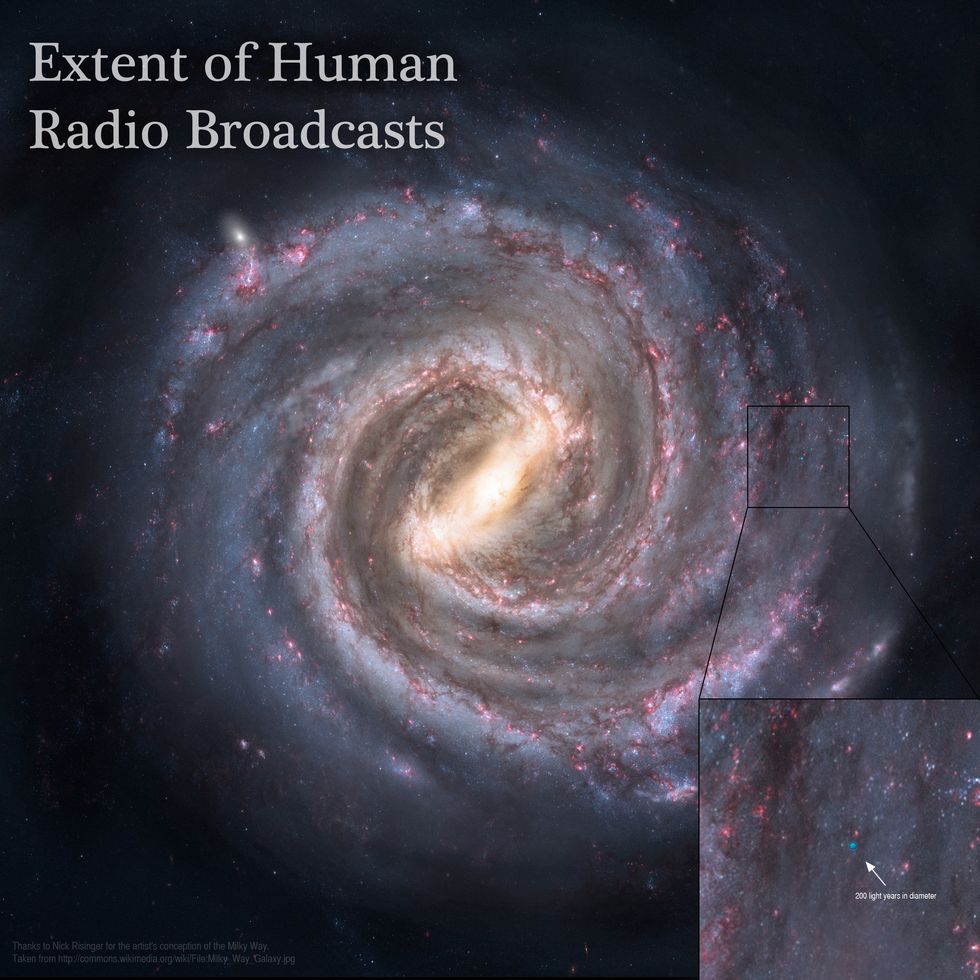
This map designed by Adam Grossman of The Dark Sky Company puts into perspective the enormity of these scales. The Milky Way stretches between 100,000 and 180,000 light-years across, depending on where you measure, which means a signal broadcast from one side of the galaxy would take 100,000 years or more to reach the other side. Now consider that our species started broadcasting radio signals into space only about a century ago. That's represented by a small blue bubble measuring 200 light-years in diameter surrounding the position of the Earth. For any alien civilizations to have heard us, they must be within the bubble.
The very first experimentation with electromagnetic radiation was conducted some 200 years ago, when Danish physicist and chemist Hans Christian Ørsted discovered that electric currents create magnetic fields. This research was expanded by scientists including Michael Faraday , and it eventually resulted in James Clerk Maxwell 's theory of electromagnetism outlined in 1865 and demonstrated by German physicist Heinrich Hertz's experiments more than two decades later. Even then, it wasn't until Italian inventor and electrical engineer Guglielmo Marconi developed long-range radio transmission technologies around the turn of the 20th century that our species really started broadcasting its existence out into the void.
.css-2l0eat{font-family:UnitedSans,UnitedSans-roboto,UnitedSans-local,Helvetica,Arial,Sans-serif;font-size:1.625rem;line-height:1.2;margin:0rem;padding:0.9rem 1rem 1rem;}@media(max-width: 48rem){.css-2l0eat{font-size:1.75rem;line-height:1;}}@media(min-width: 48rem){.css-2l0eat{font-size:1.875rem;line-height:1;}}@media(min-width: 64rem){.css-2l0eat{font-size:2.25rem;line-height:1;}}.css-2l0eat b,.css-2l0eat strong{font-family:inherit;font-weight:bold;}.css-2l0eat em,.css-2l0eat i{font-style:italic;font-family:inherit;} Even if you threw 100 darts, it's a near certainty that none would land in the little blue bubble of our radio waves
If we are optimistic, and we assume an advanced extraterrestrial species has the technological capabilities to detect humanity's very first radio waves (and distinguish them from the general background noise of the universe), we can estimate our farthest signals are a little more that 100 light-years away. If you threw a dart at the map of the Milky Way, and wherever that dart landed is where an advanced alien species resides, there would be a cosmically small probability that they live close enough to be aware of our existence. Even if you threw 100 darts, it's a near certainty that none would land in the little blue bubble of our radio waves.
The search for extraterrestrial intelligence (SETI) institute is constantly listening with our most capable radio telescopes , and they are broadcasting messages from us as well. But given the sheer size of the galaxy, SETI will likely have to listen and transmit for tens of thousands of years at least to have a chance of making contact with another intelligent species—and even that might not be long enough. Perhaps, in the meantime, we should contemplate Carl Sagan's next line in his Pale Blue Dot speech:
"In our obscurity, in all this vastness, there is no hint that help will come from elsewhere to save us from ourselves."
Source: Planetary Society

Jay Bennett is the associate editor of PopularMechanics.com. He has also written for Smithsonian, Popular Science and Outside Magazine.

.css-cuqpxl:before{padding-right:0.3125rem;content:'//';display:inline;} Space .css-xtujxj:before{padding-left:0.3125rem;content:'//';display:inline;}

NASA Puts More Money Behind Sci-Fi Plasma Rocket

Lego Just Dropped Two New Space-Centric Sets

Supermassive Forces Are Making Black Holes Collide

Are We Living in a ‘Hall of Mirrors’ Universe?

Have We Already Found Evidence of Dyson Spheres?

New Warp Drive Concept Is More Fact Than Fiction

A Glitch in Einstein’s Theory of Relativity

Wild Theory Offers Reason We Haven’t Found Aliens

Curiosity Finds Evidence of Mars’ Earth-Like Past
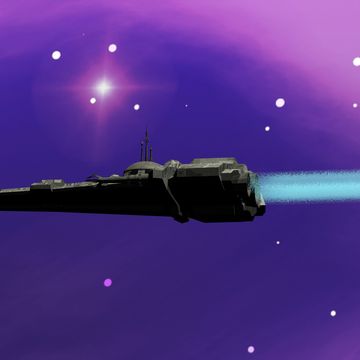
NASA's Ion Thruster Could Spawn a Space Revolution

Scientists Find Even More Evidence for Planet Nine

The importance of a script for a radio program

Waves of rebellion: the history and legacy of pirate radios

Discover the power of audio branding

Newspapers and magazines? Turn your reader into a listener

Using the internet as an extension of your radio station

Why listen to radio? The main reasons to love this medium

How far do radio waves travel?

You’ve probably experienced signal loss from an AM or FM radio station while traveling from one city to another. But do you know why this phenomenon occurs?
If you’re curious, follow our post to understand how far radio waves travel, their characteristics, limitations, and to learn some other interesting facts about the world of radio.
History of radio waves
Before we talk about the distance that radio waves can travel, it’s important to know the history of their discovery and the invention of the machines that allow humans to make use of this phenomenon. For that, let’s go back two centuries and talk about some great names in science!
James Clerk Maxwell was responsible for creating the modern theory of electromagnetism. To summarize Maxwell’s incredible work, he proved on paper, in 1865, the existence of electromagnetic waves and, consequently, radio waves.
Heinrich Hertz, using the theories created by Maxwell, demonstrated in practice that electromagnetic waves existed. In his laboratory, Hertz built a machine that generated a spark. This spark, in turn, generated an electromagnetic disturbance that propagated through the air and was captured by another part of his experiment. In short, Hertz built a transmitter and receiver of electromagnetic waves! The date? November 29, 1888.
A few years later, during the 1890s, Guglielmo Marconi invented wireless telegraphy. Building upon Hertz’s machine, Marconi managed to transmit telegraph signals through the air! First, for only 9 meters. Gradually, he improved his invention until, in 1901, he successfully transmitted a wireless telegraph signal across the Atlantic Ocean for over 3,000 kilometers.
From there, great names further developed the technology theorized by Maxwell and proven by Hertz. Guglielmo Marconi, Nikola Tesla, Thomas Edison, and the Brazilian inventor Roberto Landell de Moura were responsible for advancing Hertz’s invention and transforming the simple transmitter-receiver into a technology capable of revolutionizing the world.
The distance radio waves travel
Radio waves, as we mentioned, are vibrations in the electromagnetic spectrum. Therefore, they move at the speed of light, an incredible 300,000 kilometers per second! To understand how far radio waves can travel, we need to understand some characteristics of this phenomenon.
Characteristics of radio waves
Radio waves have characteristics that determine the transmission power, identification, position in the radio spectrum, and speed of wave movement. Here’s a brief overview of each characteristic:
Amplitude: It measures the intensity of the wave. It is the maximum distance between the crest (highest point) and the trough (lowest point) of the wave. The amplitude of a radio wave determines its transmission power, meaning the wider the wave, the farther it can be transmitted.
Wavelength: It is the distance between two consecutive crests of the wave. It can be measured in meters or other units of length. The wavelength is directly related to the frequency of the wave.
Frequency: It measures how many times the wave completes a cycle per second. It is measured in Hertz (Hz). Electromagnetic waves are categorized by their frequency. Visible light, microwaves, X-rays, and radio waves are examples of different types of electromagnetic waves.
Radio waves are characterized by having very short frequencies, much smaller than visible light. In the case of electromagnetic vibrations, the lower the frequency, the larger the size of the wave. And the larger the size of a radio wave, the farther it can travel without being affected by obstacles.
That’s why AM radio stations can travel farther away than FM radio stations! But we’ll talk more about that later on.
Limitations on the range of radio waves
In addition to characteristics such as amplitude, wavelength, and frequency, there are other factors to consider when it comes to the range of radio waves. Several factors can influence the distance that radio waves can travel. Here are some of them:
Transmitter power
The power of the transmitter is a critical factor in determining the distance that radio waves can travel. The higher the transmitter power, the farther the radio waves will travel. This is because the transmitter power determines the intensity of the radio wave. The stronger the radio wave, the farther it will travel.
However, it’s important to note that increasing the transmitter power does not automatically guarantee a longer transmission. Additionally, increasing the transmitter power can also cause issues such as interference with other radio transmissions.
Government regulations establish limits on the power of radio transmitters to ensure compatibility between various transmissions.
Interference
Interference is one of the main causes of loss of quality and distance in the propagation of radio waves. It can be caused by various factors, such as other radio transmissions, physical obstacles, electrical activity, or other types of electromagnetic pollution.
When it comes to AM and FM radios, the most common causes of interference are “pirate radios” that transmit on the same frequencies as licensed radios, thereby blocking their reception locally.
Government regulations establish standards to limit electromagnetic pollution and protect the quality of radio transmissions.
The influence of the atmosphere on the propagation of radio waves
The atmosphere has a significant influence on the range of radio waves. This is because waves travel through electromagnetic propagation, which is affected by various environmental factors such as air density, humidity, and temperature.
The atmospheric layer that has the greatest influence on the propagation of radio waves is the ionosphere. This layer is composed of ionized gases and is capable of reflecting and refracting waves at different altitudes. This ability allows radio waves to be sent over long distances. However, the ionosphere is a dynamic environment, and its properties can change depending on the time of day, season, and solar cycle. These changes can affect the range of radio waves that rely on the ionosphere for propagation.
Those who work at radio stations have encountered this phenomenon. It is common for the transmitter power of the station to be reduced at night when the ionosphere absorbs less and reflects the radio signal more.
In addition, humidity and temperature also influence the propagation of radio waves. The moisture in the air can absorb the waves, reducing their range. Temperature, on the other hand, affects the density of the air, and the lower the density, the greater the range of radio waves. Conversely, higher air density has a greater impact on radio waves. Attenuation is more pronounced at higher frequencies, which means that higher-frequency radio waves have a shorter range.
Another important factor to consider is the presence of physical obstacles such as buildings and mountains, which can block or attenuate radio waves, reducing their range. The larger the wavelength, the greater the ability to bend around obstacles and reach greater distances.
Use of radio waves
Anyone who thinks that radio waves are only used to listen to broadcast stations is mistaken. Radio waves are used for various purposes, such as military transmissions, satellite communications, amateur radio, television, among others. Here are some wave bands and their uses:
Shortwave (SW): Shortwave is used for long-distance transmissions, such as international radio, amateur radio, and military communications.
Medium wave (MW): In addition to AM radio station transmissions, medium waves are also used for maritime and aviation navigation, military communications, and car location and alarm systems.
Longwave (LW): In addition to AM radio station transmissions, long waves are also used for navigation and location systems, such as LORAN-C.
Very High Frequency (VHF) : The VHF band is used for short and medium-distance communications, such as aviation radio, emergency communications, FM radio, and television.
Ultra High Frequency (UHF): The UHF band is used for short-distance communications, such as two-way radios, cell phones, digital television, and military communications.
These are just a few of the main radio wave bands, and each of them has its own characteristics and specific applications.

Differences between AM and FM transmission
When it comes to radio waves, it’s inevitable to think of AM and FM, isn’t it? Everyone has tuned their radio to an AM or FM station to listen to their favorite programming. So it’s time to learn more details about these bands.
AM radio waves (Amplitude Modulation) are characterized by the use of amplitude modulation to transmit audio signals and data through the airspace. Due to their lower frequency range, typically between 535 kHz and 1605 kHz, they are capable of propagating over long distances. Additionally, they can be received by simple and inexpensive receivers.
However, AM radio waves have some disadvantages. One of the main drawbacks is the limitation in audio quality. They are also more susceptible to electromagnetic interference and noise.
On the other hand, FM radio waves (Frequency Modulation) are characterized by the use of frequency modulation to transmit audio signals and data through the airspace.
One of the main advantages of FM radio waves is the high audio quality that can be achieved. This is because frequency modulation allows the signal amplitude to remain constant while the frequency is changed to carry the audio information. Additionally, FM has a wider bandwidth than AM, allowing it to transmit more data in a single radio wave.
However, FM radio waves also have some disadvantages. One of them is their limited propagation, as they use a higher frequency range, typically between 88 MHz and 108 MHz. This means that FM transmissions reach a smaller geographic area. Additionally, FM receivers are generally more expensive and complex.
Web radio as an alternative
With the popularization of the internet, the possibility arose to combine the broadcasting system with streaming technology to overcome the limitations of traditional communication.
Streaming technology allows audio content to be transmitted over the internet, eliminating the need for radio waves to reach the audience. It is sent through a network of servers and routers that connect users’ devices to the internet. This process is not affected by electromagnetic interference and has no geographic limitation.
By using audio compression algorithms like MP3, which can reduce the file size without significantly affecting sound quality, audio streaming is not subject to distortions, unlike analog radio broadcasts.
In addition to these benefits, it is a cost-effective and accessible technology for everyone.
Radio is a historic means of communication and holds a special place in the hearts of people all around the world. However, as we have shown here, radio waves have their limitations in terms of range, influenced by a combination of factors including frequency, transmitter power, interference from physical obstacles, and weather conditions.
Therefore, streaming technology can be an effective alternative to expand the reach of radio stations, allowing people from different parts of the world to access content instantly and without interference.
BRLOGIC is a leading provider of audio streaming services. If you want to bring your station to the internet so that more people can listen to it, visit our website and discover the advantages.
You may also like

About the author
Luiz Silveira
Luiz Silveira is a specialist in digital marketing and a radio, music and technology enthusiast. With a decade of experience, he aims to help radio stations better position thenselves on the internet.
Add Comment
Cancel reply.

Quality and trust

Claudio Loreiro Rádio 13 de Agosto, CEO
Lifetime Partnership

Rafael Schmidt Rádio Conectados, CEO
- Become A Member
- Gift Membership
- Kids Membership
- Other Ways to Give
- Explore Worlds
- Defend Earth
How We Work
- Education & Public Outreach
- Space Policy & Advocacy
- Science & Technology
- Global Collaboration
Our Results
Learn how our members and community are changing the worlds.
Our citizen-funded spacecraft successfully demonstrated solar sailing for CubeSats.
Space Topics
- Planets & Other Worlds
- Space Missions
- Space Policy
- Planetary Radio
- Space Images
The Planetary Report
The eclipse issue.
Science and splendor under the shadow.
Get Involved
Membership programs for explorers of all ages.
Get updates and weekly tools to learn, share, and advocate for space exploration.
Volunteer as a space advocate.
Support Our Mission
- Renew Membership
- Society Projects
The Planetary Fund
Accelerate progress in our three core enterprises — Explore Worlds, Find Life, and Defend Earth. You can support the entire fund, or designate a core enterprise of your choice.
- Strategic Framework
- News & Press
The Planetary Society
Know the cosmos and our place within it.
Our Mission
Empowering the world's citizens to advance space science and exploration.
- Explore Space
- Take Action
- Member Community
- Account Center
- “Exploration is in our nature.” - Carl Sagan
Emily Lakdawalla • Feb 24, 2012
This is how far human radio broadcasts have reached into the galaxy
The other day, I was playing around with stumbleupon and came across this photo, which -- well, it speaks for itself. Wow.
Gives you perspective, doesn't it? Actually, I'm a little surprised that the dot shows up on this image at all. Some people describe this as humbling, but for me, I see it as just the beginning. I'm very grateful to be a member of the very few generations of humanity that have ever lived who are (a) capable of creating radio broadcasts and (b) realizing how much more of the universe there is beyond what we've experienced.
I tweeted a link to it, and while I expected some retweets, I was surprised to see its spread -- I think it's probably the single most retweeted tweet I have ever written. There's probably several reasons for that. Links to photos are more likely to be retweeted than others. Very short but still substantial tweets are more likely to be retweeted, because it gives the repeater scope for their own commentary. And this is the sort of thing that can make just about anybody who is capable of operating a cell phone go "hmm," so it has wide appeal.
The one thing I feel bad about is that stumbleupon sent me directly to the photo on somebody else's website, and I didn't bother looking up its origin before I tweeted the link. So now I have, and I can tell you that the diagram was made by Adam Grossman on the jackadamblog , using an artist's concept of the Milky Way by Nick Risinger that he took from Wikipedia. They have a neato-looking iOS app, Dark Sky , that provides very short-term weather predictions. My apologies, Adam, for sending so much traffic directly to the photo rather than to your blog! Hopefully this post will correct that error.
A special note to the pedants: yes, I do realize that the signal from our radio and TV broadcasts is so attenuated by that 100-light-year boundary as to be undetectable except by some kind of magical alien technology. That's not the point. Don't be so literal!
One last thing: my apologies for no post yesterday and the likelihood of very few posts next week. I have a lot of other projects going right now that do not automatically produce blog posts, and not enough time.
Your support powers our mission to explore worlds, find life, and defend Earth. Give today!
For full functionality of this site it is necessary to enable JavaScript. Here are instructions on how to enable JavaScript in your web browser .
MIT Technology Review
- Newsletters
Radio waves from Earth have reached dozens of stars
As we continue our search for extraterrestrial life, a new study estimates how many other worlds might have already spotted us.
- Tatyana Woodall archive page

For billions of years, Earth has been playing a cosmic game of hide-and-seek.
New research published today in Nature posits that roughly 1,700 stars are in the right position to have spotted life on Earth as early as 5,000 years ago. These stars, within 100 parsecs (or about 326 light-years) of the sun, were found using data from NASA’s Transiting Exoplanet Survey Satellite and the European Space Agency’s Gaia mission.
And with thousands of exoplanets already found orbiting other stars in our universe, could we have already seen life on other planets come and go? Might they have seen us?
“The universe is dynamic,” says Lisa Kaltenegger , director of the Carl Sagan Institute at Cornell, and lead author of the study. “Stars move, we move. First the Earth moves around the sun, but the sun moves around the center of our galaxy.”
About 70% of exoplanets are found using the transit method: when a planet passes between a star and an observer, the star dims enough to confirm the presence of a previously unseen celestial body.
Kaltenegger and coauthor Jackie Faherty of the American Museum of Natural History compiled a list of stars that either will see or already have seen Earth transit in their lifetimes. Of these, they found seven stars with orbiting exoplanets that could potentially be habitable.
Statistically, one out of four stars has a planet that exists in the “Goldilocks zone”—not too hot, not too cold, and just far away from a star to support life. But how do we determine whether faraway exoplanets meet these criteria?
When transiting exoplanets block stellar light, part of that light filters through the atmosphere. Energy and light interact with the molecules and atoms of that planet, and by the time that light reaches an astronomer’s telescope, scientists can determine whether it has interacted with chemicals like oxygen or methane.
A combination of those two, Kaltenegger says, is the fingerprint for life.
“What’s really interesting is people could have seen that the Earth was a habitable planet since about 2 billion years [ago], because of the oxygen buildup in the atmosphere,” she says.
The idea of studying transits to find out if we’re on someone else’s radar isn’t really new. Kaltenegger attributed much of her inspiration to a plan the SETI Institute, which pursues the search for extraterrestrial intelligence, had in the 1960s.
In 1960, a radioastronomer named Frank D. Drake was the first person to try to detect interstellar radio transmissions , focusing on two stars 11 light-years away and similar in age to our sun. Though that attempt was unsuccessful, scientists and amateur enthusiasts have continued to look for such signals ever since.
But whether the signals we send are getting through is another matter entirely. In the new study, Kaltenegger and Faherty reported that human-made radio waves had already swept over the 75 closest stars on their list.
Even though humans have been sending out radio waves for roughly 100 years, that’s nothing compared with Earth’s billions of years of planetary evolution.
Meanwhile, much of our own solar neighborhood is still unexplored, but that’s where missions like TESS, Gaia, and Kepler come in. TESS spends months looking at different sectors of the universe in its hunt to find exoplanets, and Gaia seeks to create a three-dimensional map of the entire Milky Way. But Kepler was made to observe one patch of sky for longer periods of time—the perfect way to track exoplanets using the transit method.
“With both Kepler and Gaia, one of the really big advantages was that they were able to sort of stare for a long time at the stars,” says Douglas Caldwell , a SETI researcher and instrument scientist for the Kepler mission.
Caldwell says missions dedicated to specific science goals like Gaia offer a kind of precision that he hopes will bode well for future astronomical discoveries.
“Space is really, really huge, and these stars are all really far away from us compared to things we’re used to as people,” he says. “We’re looking at our closest neighbors and kind of trying to understand our little neighborhood of the galaxy.”
The great commercial takeover of low Earth orbit
Axiom Space and other companies are betting they can build private structures to replace the International Space Station.
- David W. Brown archive page
How to safely watch and photograph the total solar eclipse
The solar eclipse this Monday, April 8, will be visible to millions. Here’s how to make the most of your experience.
- Rhiannon Williams archive page
Inside the quest to map the universe with mysterious bursts of radio energy
Astronomers still don’t know what causes fast radio bursts, but they’re starting to use them to illuminate the space between galaxies.
- Anna Kramer archive page
Astronomers are enlisting AI to prepare for a data downpour
Tailored algorithms will help filter a coming flood of astronomical observations, helping scientists make new discoveries about the universe.
- Zack Savitsky archive page
Stay connected
Get the latest updates from mit technology review.
Discover special offers, top stories, upcoming events, and more.
Thank you for submitting your email!
It looks like something went wrong.
We’re having trouble saving your preferences. Try refreshing this page and updating them one more time. If you continue to get this message, reach out to us at [email protected] with a list of newsletters you’d like to receive.
Do you love all things radio and broadcasting? We are looking for writers!

Why Do AM Signals Travel Farther?

Site Owner & Radio Enthusiast
What would you say if you had to guess whether AM or FM signals could travel farther?
Although you might assume FM signals are more suited for long distances due to their prevalence, it’s actually AM. Why can AM signals travel far?
AM signals operate on a lower frequency, increasing the size of their wavelengths. Larger wavelengths can permeate solid objects more efficiently, allowing them to cross longer distances. The traveling distance of AM signals grows even more at night.
This article will answer all your questions on AM signal travel, so don’t miss it!
Table of Contents
Why Do AM Signals Travel Far?
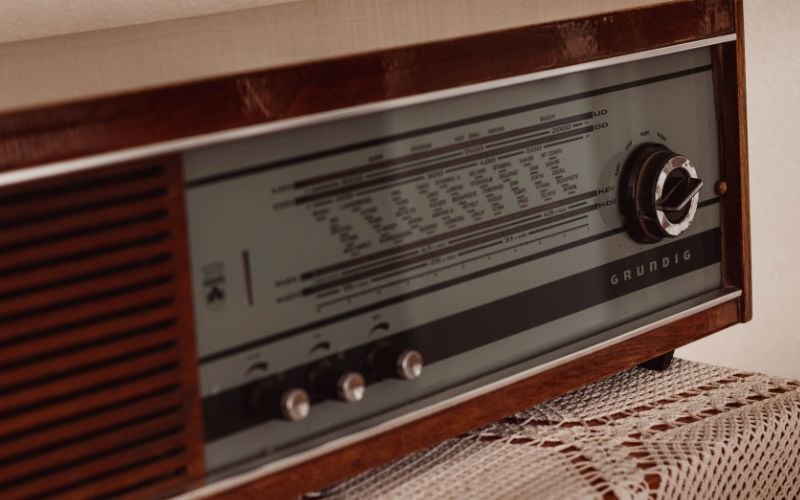
As we established in the intro, AM radio waves can travel further than FM waves.
Now let’s explore the reasons why in more depth.
AM radio operates on a frequency range of 540 to 1700 kHz. FM radio uses frequencies between 88 and 108 MHz (at least in the United States; it can vary in other parts of the world).
As you can see, AM radio waves occur at a lower frequency between the two.
Low frequencies have bigger wavelengths, and high frequencies have shorter wavelengths.
That signal length is critical, allowing AM radio waves to pass through solid objects such as rocks, trees, hills, and buildings.
FM waves get stuck on these obstacles. The shorter wavelength prevents the radio wave from permeating through.
However, an FM radio wave’s ability to travel can be lengthened depending on where it’s broadcast from.
For example, the radio wave can travel further than usual in a wide open area because it’s unobstructed.
It will not outpace the distance an AM wave can travel.
How Far Can an AM Signal Reach?
Radio broadcasters and listeners must consider the distance AM and FM wavelengths can travel.
By day, an AM signal has an average broadcasting scope of 100 miles. By night, you can add on hundreds of miles more, says the FCC .
For comparison’s sake, an FM signal generally travels between 30 and 40 miles.
Do AM Signals Travel Farther by Day or By Night?
You’ll recall we mentioned a difference between an AM signal’s ability to travel at night versus by day. That’s no coincidence.
We just wrote a whole post dedicated to AM signal travel by night, so we’ll provide a brief recap here.
A radio wave’s ability to travel is affected by the ionosphere.
The ionosphere has molecules seeking bonds across several layers. The molecules will attach faster on some ionospheric levels than others.
During the day, the molecules remain unbonded more than at night. These unbonded molecules across the ionosphere operate the same as any obstacle.
An AM radio wave can pass through the obstacle, but it limits the extent of the signal.
This is why AM radio achieves an average broadcasting distance of 100 miles during the day.
The sun ionizes the molecules, so once it sets, they behave differently. The molecules will pair up at night, reducing their surface area and allowing AM waves to travel hundreds of miles.
The propensity for travel at that point is significant enough that the FCC requires some AM stations to reduce power or stop broadcasting at night if they don’t have safety measures.
Have you ever heard of such a measure required for FM radio? No!
You can usually tune into FM anytime, 24/7, because the signal distance doesn’t increase at night like an AM signal does.
Can You Extend the Distance of an AM Signal?

What if you want to extend AM signal range even more? You can try a few techniques, so let’s review them.
Reduce Interference
AM radio is even more prone to interference than FM, even if the former radio waves can pass through solid obstacles better.
As we discussed earlier, broadcasting in an open area is best.
The site should have few, if any, trees, hills, rocks, power lines, and buildings (well, besides the one you’re broadcasting from, if you’re indeed broadcasting indoors!).
Many everyday household objects can interfere with AM signals, dampening reception, as we wrote about here .
Be wary of anything electronic, from bug zappers to lights (even holiday lights), electric blankets, smartphone chargers, microwaves, computers and laptops, monitors, and televisions.
Consider powering off these devices when broadcasting or using AM radio.
If you’re listening to AM on a portable radio, you can also move the radio further from the source of these objects if you can’t unplug them for any reason.
Use at Night
AM radio waves travel much further at night.
Stations that you might have only barely been able to hear during the day because the interference was so severe can become clear and listenable once the sun sets.
However, we must stress that this only applies to some AM stations. Some will reduce their power load at night per FCC requirements.
When broadcasting at lower power, the distance the radio signals can travel might lessen.
Others have to stop broadcasting altogether!
Try an Antenna Booster

Positioning a portable radio antenna can improve the signal, but an antenna booster takes things one step further.
It amplifies the signal, enabling it to reach further distances.
You can always create an antenna booster or amplifier yourself or purchase one.
Here’s how an antenna booster works.
Most include an RF amplifier stage that can elevate the signal.
However, noise is equally amplified, so whether it’s a subtle hissing tone or a loud popping or humming, those sounds will come through loud and clear.
Make sure you know what’s causing interference around the AM radio signal, and do your best to minimize those sources of interference. This will spare everyone’s ears when they tune in.
Use a Transmitter
A radio transmitter is the last option to extend an AM signal’s length.
FM transmitters convert FM into AM signals, then transmit them over further distances, but you can also purchase an AM transmitter.
Transmitters can be high-level or low-level, the former of which uses high-level modulation.
That’s the standard choice when broadcasting on AM airwaves, especially if your transmitting power is mere kilowatts.
However, suppose you’re broadcasting but already have more transmitting power to your setup.
In that case, there’s no need to harness the power of high-level modulation. You can always use a low-power transmitter instead.
A radio transmitter includes a carrier oscillator, which produces a high-frequency carrier signal.
The carrier oscillator uses a sub-multiple frequency to keep the carrier frequency stable. This multiplies with a frequency multiplier to provide the required carrier frequency.
The transmitter also uses a buffer amplifier to isolate the frequency multiplier and carrier oscillator.
The amplifier sets the frequency multiplier’s input impedance and the carrier oscillator’s output impedance as the same.
Why do this? It prevents the multiplier from generating too large of a current.
There’s also a power amplifier. As the name suggests, this increases the carrier signal’s power.
Wrapping Up
AM signals can travel farther than FM signals due to the size of the wavelength.
The wavelengths are larger and thus have no issue passing through obstacles such as trees, buildings, and hills.
The traveling distance of AM signals amplifies even more at night.
Whereas the radio signal only travels about 100 miles during the day (which is still over 50 miles more than an FM radio wave’s average traveling distance), it becomes hundreds of miles more after dark due to sky wave propagation.
While you can use handy tools like a radio transmitter or antenna booster to lengthen an AM signal, remember that noise is often amplified with the signal.
Reducing noise as much as possible will enhance the clarity of the signal.

When my grandfather would come to visit me as a kid, we used to sit in his RV and listen to the activity on his CB radio. His nickname for me was “Charlie” and asked me what my call sign would be. I told him it’s “Wide Receiver”, as a play on receiving radio signals and also for my dream of playing a wide receiver in football at the time.
Similar Posts

How to get your song on the radio: Everything you need to know
Erin Shine Site Owner & Radio Enthusiast Even to this day, “how to get your song…

DAB car aerial installation: How to fit a DAB windscreen aerial
Steve Harvey Contributing Editor Wondering how to improve DAB radio reception in your car? The easiest option…

How Far Can You Talk on a 10-Meter Ham Radio?
How far can you talk on a 10-meter ham radio? You won’t want to miss this post to learn the answer.

Best AM/FM radio: Brilliant AM/FM solutions for radio lovers
William Baker Contributing Editor The best AM/FM radio gives you more control over your station options….

Shortwave Radios In Emergencies: Everything You Need To Know
If you’re curious about using shortwave radio in emergencies, we’ve got you covered in this one. We talk about the basics, along with specifics of why these radios work well, and even include popular ones you can buy now.

Brace for Impact: Best Weather Radios to Keep You Safe
Find the best weather radio on this list of 10 options, available at various price points.
Israel-Gaza latest: Hamas responds to ceasefire proposal - as Netanyahu casts doubt on deal
Joe Biden announced a surprise plan with three phases: the first would be a six-week ceasefire, the second the return of remaining hostages, and the third a reconstruction plan for Gaza. We'll be bringing you all the reaction to this throughout the day.
Sunday 2 June 2024 07:16, UK
- Israel-Hamas war
Please use Chrome browser for a more accessible video player
- US President Joe Biden announces new ceasefire and hostage deal proposal
- Hamas views latest proposed deal 'positively'
- Israel's conditions for ending the war have not changed, Netanyahu's office says
- Chances of ceasefire 'not that realistic', expert says
- Egypt making 'intensive efforts' to resume negotiations - report
- Israeli opposition leader urges Netanyahu to take deal - and says he will prop up government
- Explained: What is in Biden's three-phase plan?
- Analysis: Israel seemed blindsided by Biden announcement
- Live reporting by Emily Mee
We will be focusing on our general election coverage tomorrow, but we'll be back with more live updates on the Israel-Hamas war next week.
Models Bella and Gigi Hadid are collectively donating one million dollars (£785,000) to support relief efforts, according to their agent.
The money will go to Heal Palestine, Palestine Children's Relief Fund (PCRF), World Central Kitchen (WCK), and United Nations Relief and Works Agency (UNRWA).
The sisters have frequently been vocal in their support for Gaza, and their father Mohamed Anwar Hadid is himself Palestinian.
After Hamas's 7 October attack on Israel, Gigi, 29, offered her condolences to those affected.
"My thoughts are with all those affected by this unjustifiable tragedy, and every day that innocent lives are taken by this conflict - too many of which are children," she wrote on Instagram.
"I have deep empathy and heartbreak for the Palestinian struggle and life under occupation, it's a responsibility I hold daily."
She added: "While I have hopes and dreams for Palestinians, none of them include the harm of a Jewish person."
Bella, 27, said in May that she was "devastated at the loss of the Palestinian people and the lack of empathy coming from the government systems worldwide".
The United Nations food agency has said it is unable to feed most civilians in the southern Gaza city of Rafah.
Only 27,000 people in Rafah are currently being reached by the World Food Programme (WFP), according to its local director Matthew Hollingworth.
Roughly one million Palestinians are living in the area, many of them displaced from other parts of Gaza.
"The sounds, the smells, the everyday life are horrific and apocalyptic," Mr Hollingworth told journalists.
"People sleep to the sounds of bombing, they sleep to the sounds of drones, they sleep to the sounds of war, as now tanks roll into parts of central Rafah, which is only kilometers away. And they wake to the same sounds."
A ceasefire proposal consisting of three phases has been outlined by Joe Biden.
What do those phases entail, what have Israel and Hamas said about the plan and how does it compare to the last proposal?
Read more below...
The French president has backed the ceasefire proposal set out by Joe Biden last night.
Emmanuel Macron said he supported the proposal for "a durable peace" and that the war "must end".
France is also working with partners in the region on "peace and security for all", he said.
A high-level official has said Egypt is undertaking "intensive efforts" to "resume negotiations" for a ceasefire and hostage deal, according to a report.
The official, quoted by Al-Qahera TV, said this was "in light of the recent American proposition".
Last night, Joe Biden detailed a ceasefire and hostage deal proposal that he said Israel had put to Hamas.
However, Israeli officials have told our correspondents they were "blindsided" by the announcement.
If it works, then this will be a smart and cunning diplomatic move.
If it doesn't then President Joe Biden will look foolish.
He knows the huge risk of once again being taken for a ride by Israeli Prime Minister Benjamin Netanyahu.
Few knew that he was due to make this announcement.
Read more from our US correspondent Mark Stone below...
The Palestinian Red Crescent Society (PRCS) has said 33 of its employees have been killed in Gaza since the war began.
Of those, it said 19 were killed "while performing their humanitarian duties".
The organisation today buried Mohammed Jihad Abed, an employee in the disaster risk management department.
He was killed in an Israeli attack on his home in Rafah last night.
American, Egyptian and Israeli officials will be meeting tomorrow in Cairo to discuss the reopening of Gaza's Rafah crossing, according to a report.
Egypt is insisting that Israel withdraw its forces from the crossing, a high-level source told Egypt's state-linked Al Qahera TV.
Israel seized the Gaza side of the crossing last month during its offensive in the city of Rafah.
Earlier this week, a member of Egypt's security forces was killed in a shooting incident near the Rafah crossing.
An Egyptian soldier stationed on a watchtower had reacted to seeing an armoured vehicle carrying Israeli troops cross a boundary line near the border while the soldiers pursued and killed several Palestinians, two Egyptian security sources told Reuters news agency.
The soldier opened fire and Israeli forces fired back, killing him, the sources said, sparking an exchange of gunfire between the two sides.
The British prime minister has praised the proposed ceasefire deal set out by Joe Biden, saying it is "welcome news".
Rishi Sunak said he hopes Hamas "takes this opportunity to take this deal that is on the table, [and] that would ensure hostages can be released and be back with their families".
He also expressed hopes to "flood Gaza with far more aid than has been getting in" and to "use that pause in the fighting to build a sustainable and lasting peace".
Mr Sunak joins a growing group of world leaders expressing support for the deal, which will only put more pressure on Israel and Hamas.
Be the first to get Breaking News
Install the Sky News app for free


IMAGES
VIDEO
COMMENTS
If your horizon is 20 miles away, you must be about 20 feet tall or something. Normal people have a horizion about 5 miles away. Note that horizon distance is affected by frequency, because lower frequencies refract towards the earth and travel further. VHF is about 5 miles.
These are typically 2 or 3 meters (6 to 10 feet) in diameter. The Voyager spacecraft has an antenna dish that is 3.7 meters (14 feet) in diameter, and it transmits to a 34 meter (100 feet or so) dish on Earth. The Voyager dish and the Earth dish are pointed right at each other. When you compare your phone's stubby, little omni-directional ...
We've been sending radio waves for over a century, but how far have they got?Subscribe to our YT: https://bit.ly/2GjvyNsJoin 25M followers on Facebook: https...
Radio propagation is the behavior of radio waves as they travel, or are propagated, from one point to another in vacuum, or into various parts of the atmosphere. [1] : 26‑1 As a form of electromagnetic radiation, like light waves, radio waves are affected by the phenomena of reflection, refraction, diffraction, absorption, polarization, and ...
"Restricting the selection to the distance radio waves from Earth have traveled- about 100 light-years - leads to an estimated 29 potentially habitable worlds that could have seen Earth transit and also detect radio waves from our planet," say Kaltenegger and Faherty. Of course, the possibility of life on these worlds is entirely unknown.
Radio waves have the longest wavelengths in the electromagnetic spectrum. They range from the length of a football to larger than our planet. Heinrich Hertz proved the existence of radio waves in the late 1880s. He used a spark gap attached to an induction coil and a separate spark gap on a receiving antenna. When waves created by the sparks of ...
First, the radio station encodes some information on a radio wave. This is known as modulation. They then broadcast the radio wave with the encoded information onto a certain frequency. Your radio antenna picks up the broadcast based on the frequency to which your radio dial is tuned. Your radio then decodes the information from the radio wave ...
radio wave, wave from the portion of the electromagnetic spectrum at lower frequencies than microwaves. The wavelengths of radio waves range from thousands of metres to 30 cm. These correspond to frequencies as low as 3 Hz and as high as 1 gigahertz (10 9 Hz). Radio-wave communications signals travel through the air in a straight line, reflect ...
Radio waves will also be adversely affected by metal and water, which they cannot pass through. That is because water and metal are both electrical conductors. Like the ionosphere, metal and water contain many free electrons, which will vibrate when a radio wave hits the surface, and the wave will bounce back.
Actually, radio waves travel very quickly through space. Radio waves are a kind of electromagnetic radiation, and thus they move at the speed of light. The speed of light is a little less than 300,000 km per second. At that speed, a beam of light could go around the Earth at the equator more then 7 times in a second. The reason that it takes so ...
Not all radio waves travel farther at night than during the day, but some, short and medium wave, which AM radio signals fall under, definitely can given the right conditions. The main reason this ...
Understanding Radio Waves: Nature and Properties. Radio waves, the unsung heroes of the electromagnetic spectrum, serve as the cornerstone of amateur radio, enabling enthusiasts to experiment, communicate, and explore a world invisible to the naked eye. These waves, oscillating electric and magnetic fields that travel through space at the speed ...
The Milky Way stretches between 100,000 and 180,000 light-years across, depending on where you measure, which means a signal broadcast from one side of the galaxy would take 100,000 years or more ...
The distance radio waves travel. Radio waves, as we mentioned, are vibrations in the electromagnetic spectrum. Therefore, they move at the speed of light, an incredible 300,000 kilometers per second! To understand how far radio waves can travel, we need to understand some characteristics of this phenomenon.
Wow. Extent of human radio broadcasts Humans have been broadcasting radio waves into deep space for about a hundred years now, since the days of Marconi. That, of course, means there is an ever-expanding bubble announcing Humanity's presence to anyone listening in the Milky Way. This bubble is astronomically large (literally), and currently ...
The only man made object that has gone really far is Voyager 1, which is at a distance of 18.7 billion kilometers (125.3 AU) from the sun. Although launched in 1977, it is the only live transmitter and receiver which is that far. The radio communication system of Voyager 1 was
In the new study, Kaltenegger and Faherty reported that human-made radio waves had already swept over the 75 closest stars on their list. Even though humans have been sending out radio waves for ...
Why Do AM Signals Travel Far? AM radio waves can travel further than FM waves due to a longer signal length that more easily transfers through obstacles. As we established in the intro, AM radio waves can travel further than FM waves. Now let's explore the reasons why in more depth. AM radio operates on a frequency range of 540 to 1700 kHz.
Joe Biden announced a surprise plan with three phases: the first would be a six-week ceasefire, the second the return of remaining hostages, and the third a reconstruction plan for Gaza. We'll be ...